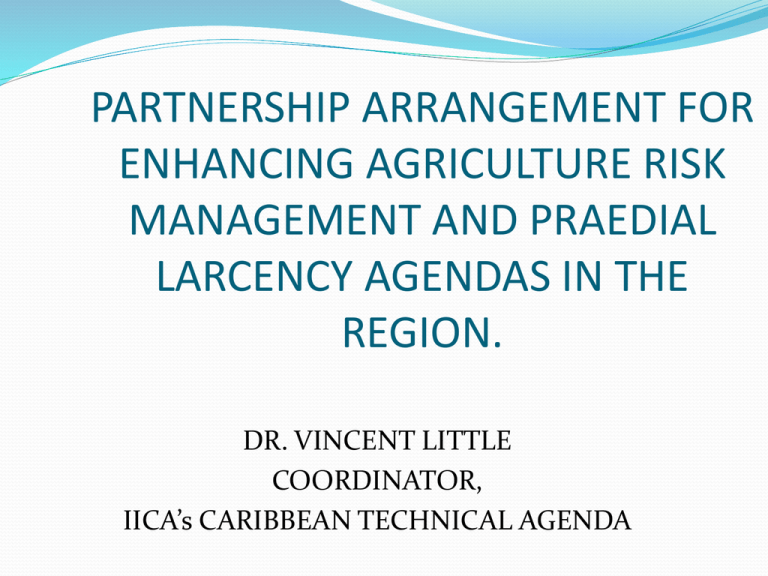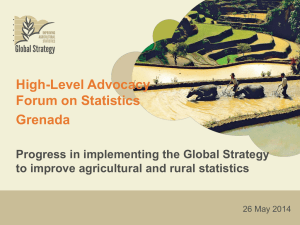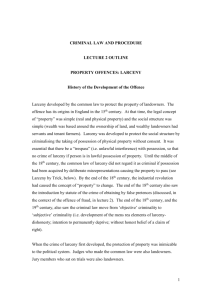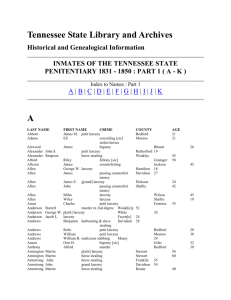Agriculture Sub-sector Committee
advertisement

PARTNERSHIP ARRANGEMENT FOR ENHANCING AGRICULTURE RISK MANAGEMENT AND PRAEDIAL LARCENCY AGENDAS IN THE REGION. DR. VINCENT LITTLE COORDINATOR, IICA’s CARIBBEAN TECHNICAL AGENDA TABLE OF CONTENT Background CARM Strategy Agricultural Insurance Agenda Praedial Larceny Agenda BACKGROUND Caribbean Region is comprised mainly of: Small Island Developing States (SIDS) and Low Lying Coastal States (LLCS) Second most prone region in world to natural disaster Region experiences regular annual losses due to natural events in the order of US $3.0 billion. DAMAGE DONE TO THE AGRICULTURAL SECTOR COUNTRY DISASTER ESTIMATED VALUE DOMINICA Luis and Marilyn (1995) US $ 12 million GRENADA Ivan (2004) US $ 36.6 million GUYANA Floods (2004/2005) US $ 54.5 million Floods (2005/2006) US $ 22.5 million JAMAICA Gilbert (1988) J $ 1.66 billion ST. KITTS/NEVIS Luis (1995) US $ 15 million ST. LUCIA Allen (1980) US $ 16.9 million Dean (2007) US $ 10 million MAJOR HURRICANES IN THE CARIBBEAN BY DECADE, 1970-2008 CATEGORIES 1970OF 1979 HURRICANE CATEGORY 3 CATEGORY 4 CATEGORY 5 TOTAL 19801989 19901999 20002008 9 3 3 7 7 3 11 12 2 10 12 7 15 17 25 29 INCREASED ECONOMIC COSTS TO THE SECTOR DUE TO: Increased capital assets accumulation within the sector Strengthened inter-sectoral linkages Increased persistent poverty Continued demographic growth and shifts Migration towards coasts and river-beds of mega-cities Increased probability of occurrence of severe weather events THE JAGDEO INITIATIVE In 2003, President Jagdeo asked IICA and FAO to assist in the development of a framework for a regional agricultural repositioning strategy. 25th CHG (July/04) – Heads endorsed the Framework Proposal, which contained the Jagdeo Initiative’s vision, scope, focus and process. The Initiative is the main vehicle for the implementation of the CARICOM CAP, with a focus on addressing 9 Key Binding Constraints to the development of agriculture. NINE KEY BINDING CONSTRAINTS OF JAGDEO INITIATIVE 1 LIMITED FINANCE AND INADEQUATE NEW INVESTMENTS BARBADOS/CDB 2 OUTDATED,INEFFICIENT AGRICULTURE HEALTH AND FOOD SAFETY SYSTEMS TRINIDAD AND TOBAGO/CARICOM 3 INADEQUATE RESEARCH AND DEVELOPMENT ST. LUCIA/CARDI 4 FRAGMENTED AND DISORGANIZED PRIVATE SECTOR ST. VINCENT AND THE GRENADINES/CABA 5 INEFFICIENT LAND AND WATER DISTRIBUTION GUYANA/FAO AND MANAGEMENT SYSTEMS 6 DEFICIENT AND UNCOORDINATED RISK MANAGEMENT MEASURES, INCLUDING PRAEDIAL LARCENY ANTIGUA AND BARBUDA/FAO 7 INADEQUTE TRANSPORT ST. KITTS AND NEVIS/CARICOM 8 WEAK MARKETS AND MARKET DEVELOPMENT AND LINKAGES JAMAICA/CABA ESTABLISHMENT OF TMACs ESTABLISHMENT OF A TECHNICAL MANAGEMENT ADVISORY COMMITTEE (TMAC) FOR EACH KEY BINDING CONSTRAINT (KBC) CHAIRED BY THE MINISTER OR NOMINEE. LEAD AGENCY RESPONSIBILITY FOR – ENSURING THE TECHNICAL AND REGIONAL PERSPECTIVES AND SYNERGIES COORDINATING THE DEVELOPMENT AND IMPLEMENTATION OF ANNUAL WORK PROGRAMME CDEMA GOVERNANCE STRUCTURE Harmonization Council (CHC) Sector committees (5) Agriculture Sub-sector Committee (ASSC) ASSC/TMAC COMMITTEE Amalgamation of the: TMAC of the Jagdeo Initiative and CDEMA ASSC Committee THE COMMITTEE Minister of Agriculture, Lands, Housing and Environment of Antigua & Barbuda - Chair United Nations Food & Agriculture Organization (FAO) – Lead Agency Inter- American Institute for Cooperation on Agriculture (IICA) – Technical Support Agency Caribbean Disaster Emergency Management Agency (CDEMA) United Nations Economic Commission for Latin America and the Caribbean (UNECLAC) Caribbean Agriculture Research and Development Institute (CARDI) – Technical Support Agency CARICOM Secretariat Caribbean Community Climate Change Centre (CCCCC) Caribbean Institute of Meteorology and Hydrology (CIMH) University of the West Indies Centre for Resource Management and Environmental Studies (CERMES) Caribbean Regional Fisheries Mechanism (CRFM) Caribbean Farmers Network (CaFAN) Some form of representation from the Insurance Sector Caribbean Food and Nutrition Institute (CFNI) Organization of Eastern Caribbean States (OECS) WORK PROGRAMME OF THE ASSC/TMAC Three- year Work Programme (2010-2012) D-Group Agricultural Insurance Symposium – June 2010 Agricultural Risk Management Framework Developed Agricultural Insurance Plan of Action Developed. Praedial Larceny Agenda Evolving COMPREHENSIVE AGRICULTURAL RISK MANAGEMENT (CARM) STRATEGY FOR THE CARIBBEAN GOAL Present a systematic and logical roadmap for the implementation of actions aimed at addressing agricultural risks at the regional, national and community level through effective and efficient programmes of mitigation, , management, and coordinated response to natural, technological and manmade hazards, and the effects of climate change on the sector. OBJECTIVES To enhance the institutional framework and establish an effective mechanism and programme for agricultural risk management (ARM). To enhance the preparedness, response and mitigation capacity and mechanism for risk management in the agriculture sector in Member States as well as at the Regional level To provide emergency assistance in the management of invasive species. To support the development and promotion of national agendas for addressing praedial larceny in the region, including the legislative framework and related information and infrastructure. ELEMENTS OF THE STRATEGY Agri-business segmentation Risk assessment Institutional capacity building Risk financing. AGRI-BUSINESS SEGMENTATION Social vs. Commercial insurance Traditional farming sector Commercial farming sector Emerging farming sector. WHY SEGMENTATION TO DETERMINE ISSUES SUCH AS: Capacity to implement best practices Degree of risk awareness Affordability Risk management culture. AGRICULTURAL RISK ASSESSMENT Risk identification Risk quantification Risk prioritization Probabilistic agricultural risk model RISK, VULNERABILITY AND CAPACITY ASSESSMENTS Hazard analysis Exposure analysis to value assets at risk Vulnerability analysis Damage and Loss analyses Three complimentary activities: Management and dissemination of knowledge on risk. Effective early warning systems, including for famine, drought, hurricanes and floods. Communication and awareness promotion about hazard threats INSTITUTIONAL CAPACITY BUILDING COMPONENTS OF CAPACITY BUILDING Data management Regulatory/supervisory framework Information and Education Technical expertise Programme administration and management. DATA MANAGEMENT Meteorological data archiving Weather and climate forecasting and monitoring systems Packaging and transfer of data to end users for decision making. REGULATORY/SUPERVISORY Establishing a stable legal framework for disaster risk management Strengthen national and regional disaster management agencies and establishment of stronger co-ordination mechanisms between relevant line ministries Linking community-level experience with nationallevel policy making Strengthen building codes and land-use INFORMATION AND EDUCATION Establishing/strengthening of the information infrastructure for decision making, knowledge sharing and management of agricultural risk in the region Standardization of existing educational and training materials for agricultural risk management Establishing strategy and curriculum for building a culture of safety in the region Developing agricultural risk management tool kit for farmers in the region Developing and implementing communication/public awareness programmes TECHNICAL EXPERTISE Promoting technical and physical risk mitigation Developing agricultural risk management protocols and resource facility Improving national and local capacities for disaster prevention and mitigation, preparedness and response Enhancing national and regional capacities for the conduct of disaster damage assessment and the design of rehabilitation/reconstruction plans Providing emergency assistance in the management of invasive species Supporting the development and promotion of national agendas for addressing praedial larceny RISK FINANCING STRATEGY OBJECTIVES Identify the players and their potential contribution (value added) to risk financing Determine the risk bearing capacity of the various players Identify the financial instruments that are most suitable to transfer the risks. RISK INSTRUMENTS Agricultural insurance and reinsurance Catastrophic bonds (‘Cat bonds”) Weather derivatives Future markets Mutual funds Personal savings Natural disaster funds and other public instruments, such as safety nets for the most vulnerable (micro-credit and cash transfers) Public activities in agricultural mitigation and adaptation. AGRICULTURAL INSURANCE REGIME AGRICULTURAL INSURANCE SCHEMES UNDERDEVELOPED Asymmetric information High administrative costs Mismatch between farmers preferences and capacity to pay Distorted Government incentives and lack of political will Reluctance of reinsurers to enter the market RENEWED INTEREST IN INSURANCE Increasing frequency and cost of natural disasters Strong links between shocks and poverty Need to increase agricultural competitiveness in light of ongoing trade integration efforts and globalization Promising advances in sensing technologies, computing power, telecommunications, and probabilistic risk modelling. DESIRABLE CHARACTERISTICS: Cost effective (accessible to the producers) Easy to administer and operate Not subject to moral hazard: takes into account incentives and strategic responses from producers Cover a wide range of risks Benefit payments are fast, effective and transparent Financially sustainable (access to international financial markets). AGRICULTURAL INSURANCE PROGRAMME SUSTAINABILITY COUNTRY PERIOD ANALYZED COST vs. PREMIUM RATIO (A+I/P) BRAZIL 1975/1981 4.57 COSTA RICA 1970/1989 2.80 JAPAN 1985/1989 4.56 MEXICO 1980/1989 3.65 PHILIPPINES 1981/1989 5.57 1999 3.68 1990/2009 0.83 USA SPAIN PLAN OF ACTION FOR INSURANCE Assessing the general demand for agricultural insurance by identifying objectives – social vs. commercial and target audience. Identifying those agricultural crops and producer composition, infrastructure and perils for which cost effective insurance is attainable Conducting risk assessments, vulnerability assessments and risk prioritization PLAN OF ACTION FOR INSURANCE Assessing the available products and supply of insurance/reinsurance to support initiatives Assessing the feasibility of up scaling existing initiatives such as WINCROP to cover multi-perils and crops Assessing the role of Government in the provision of administrative oversight, information systems, legal and regulatory framework, etc. PLAN OF ACTION FOR INSURANCE Determining effective channels of distribution Designing and implementing a regional catastrophic risk facility for the sector (CCRIF or not) Developing pilot schemes Developing information and education programmes PRAEDIAL LARCENY AGENDA PRAEDIAL LARCENY CONSULTANCY THE BEAST What we no longer see are desperate individuals trying to satisfy themselves with a single act. What we are now seeing are expert ‘farmers and butchers’ who drive in vehicles and are well equipped to facilitate their nefarious activities. Those engaging in Praedial Larceny are now highly sophisticated and that their actions are causing despair for the victims. Those victims of Praedial Larceny are men and women who have invested their savings, who have mortgaged their properties REGIONAL COST OF PRAEDIAL LARCENY Loss of crops and livestock In Jamaica - the annual loss to Praedial Larceny is estimated at J $ 5.0 billion (US $ 60 million). Caribbean – annual loss is estimated at US $385 million Reduced levels of farmers profitability Loss of investments – disincentive for investments Threat to human health and safety Loss of good genetic material ROLE OF PUBLIC – PRIVATE SECTOR Agriculture must take a holistic approach to address Praedial Larceny Must involve all stakeholders – government, judiciary and producers along the entire value chain STRATEGY MUST INVOLVE: Public Awareness and Public Education Re –education of the police and Judiciary Strengthening of Existing Laws and Legislation The establishment of traceability system Appointment of Chief Praedial Larceny Officer RE-EDUCATION OF POLICE AND JUDICIARY Resident magistrates and police must not treat thieves too leniently Praedial Larceny must be seen as a crime. The real issue is crime Assets earned through Praedial Larceny must be included in the Proceeds of Crime Act and treated the same way that assets from drugs and other organized crimes are treated. Convicted praedial thieves must be bound to compensate their victims Promotion of call in services STRENGTHENING OF EXISTING LAWS AND LEGISLATION Stiffer penalties to include: Increasing fines and sentences. Instituting a three strike system Reviewing laws and penalties for individuals who accept stolen goods Implementing a mechanism for compensating farmers from fines collected. ESTABLISHMENT OF TRACEABILITY SYSTEM Record keeping by farmers Registration of producers and vendors. Introduction of receipt books within the context of a Sale of Produce Act Re-introduction or introduction of slaughter Register Certification of Abattoirs Mapping of Hot Spots APPOINTMENT OF CHIEF PRAEDIAL LARCENY OFFICER Establishes a Focal Point Gives impetus to the implementation of an aggressive programme THANK YOU










